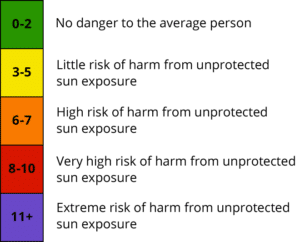It’s no surprise that extended exposure to the sun’s UV rays has been linked to eye diseases such as cataracts, macular degeneration, and other illnesses that cause vision loss. Protecting your eyes from these harmful rays should be a priority for adults and children alike.
This UV Index devised by the Environmental Protection Agency and National Weather Service provides a color-coded warning system to alert people to the dangers of being outdoors on certain days:
Dangers from unprotected UV rays can do more than just cause vision problems, it can also suppress the immune system, cause premature aging of the skin, and even become the cause of skin cancer.
In honor of UV Protection Month, keep in mind that the following factors can increase your exposure to higher UV levels:
- Geographic location that’s closer to the earth’s equator
- Higher altitudes
- Time of the day: typically avoid the hours between 10AM – 2PM
- Highly reflective surfaces such as snow, water, or sand
- Certain medications
Remember, UV radiation eye damage is cumulative, meaning the danger continues to grow as we spend time in the sun throughout our lifetime. The doctors at Michigan Eye Institute recommend wearing good, quality sunglasses whenever outdoors, particularly glasses that block 100 percent of UV rays and that also absorb HEV rays.
Ask your MEI doctors which options are best. To protect as much of the delicate skin around your eyes (the first part of your face to begin wrinkling!), opt for larger lenses or a close-fitting wraparound style. For those who are active, ask about our performance-based and sport sunglasses.
You can contact one of Michigan Eye Institute’s five locations – Flint, Fenton, Lapeer, Grand Blanc, or Oxford – by calling (810) 733-7111 or visiting www.mieye.com.
Comments are closed.




